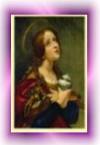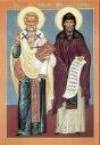And He Appeared in Their Midst: “Jesus of Nazareth” at the Bookstore
The book most beloved of its author has been released in various languages. Joseph Ratzinger has worked on it for many years, and he’s now preparing its sequel. It’s also a fundamental text for understanding this pontificate
by Sandro Magister
ROMA, April 16, 2007 – As of today, the eightieth birthday of Benedict XVI, his highly anticipated book “Jesus of Nazareth” is on sale in its original German version, and in the Italian, Polish, and Greek versions. These will soon be followed by translations in nearly twenty other languages: English, French, Spanish, Portuguese, Catalan, Dutch, Swedish, Slovenian, Croatian, Serbian, Czech, Slovak, Lithuanian, Hungarian, Maltese, Korean.
“Jesus of Nazareth” is the first part of a two-volume work that Joseph Ratzinger conceived many years ago as part of his “long interior journey” in search of “the face of the Lord.” He wrote the first four chapters before being elected pope, and the following six, “using all my free moments,” afterward.
In this first volume, the narrative begins with the baptism of Jesus in the Jordan, and continues to his transfiguration on Mount Tabor. The second volume will continue to his passion, death, and resurrection, with another chapter dedicated to the accounts of his infancy: the annunciation, his birth, the wise men, the flight into Egypt.
In the preface, Ratzinger explains his intention in writing this book: to present the Jesus of the Gospels to the men of today as the historically real Jesus, true God and true man.
For Benedict XVI, the Gospels contain all of the elements needed to affirm that the historical personage of Jesus is also truly the Son of God – both believer and nonbeliever – in the search for and discovery of his true face.
The book is composed of a preface, already made public last November, an introduction, ten chapters, and a bibliography.
In the introduction, Benedict XVI presents Jesus as the “new Moses” proclaimed by the Old Testament in the book of Deuteronomy: “a prophet with whom the Lord spoke face to face.” But it goes much further: if Moses could not contemplate the face of God, but could only see his “shoulders,” Jesus is not only the friend of God, but his only-begotten Son; he is “in the bosom of the Father” and therefore can reveal him: “He who sees me sees the Father.”
The first chapter is dedicated to the baptism of Jesus in the Jordan. Immersing himself in the water, Jesus “accepts death for the sins of humanity” – while the voice from heaven that proclaims him the beloved Son of God “is an anticipation of the resurrection.” The trajectory of his life is already drawn.
Chapter two: the temptation of Jesus. In order to save humanity, Jesus must overcome the main temptations that, in different forms, threaten men in every era. And by transforming them into obedience, he reopens the way to God, to the true Promised Land that is the “kingdom of God.”
The third chapter is dedicated to the Kingdom of God, which is the lordship of God over the world and over history, but is identified with the very person of Jesus, living and present here and now. In Jesus, “God comes to meet us – he reigns in a divine way, meaning without worldly power; he reigns with a love that endures ‘to the very end‘.”
Chapter four: the sermon on the mount. In this, Jesus appears as the “new Moses,” who brings to fulfillment the Torah, the law. The Beatitudes are the hinge of the new law and, at the same time, a self-portrait of Jesus. He himself is the law: “This is the point that demands a decision, and thus it is the point that leads to the cross and the resurrection.”
Chapter five: the Lord’s prayer. Having become a follower of Jesus, the believer can call upon the Father with the words that Jesus taught him: the Our Father. Benedict XVI explains this point by point.
Chapter six: the disciples. Their fellowship with Jesus gathers the disciples into the “we” of a new family, the Church, which is in turn sent out to bring his message to the world.
Chapter seven: the parables. Benedict XVI illustrates the nature and purpose of these, and then comments on three of them, all from the Gospel of Luke: the parable of the good Samaritan, the one about the two brothers and the good father, and the one about the rich pleasuremonger and the poor Lazarus.
Chapter eight: the great Johannine images – water, the vine and wine, bread, the shepherd. The pope comments on these one by one, after having explained who the evangelist John was.
Chapter nine: the confession of Peter and the transfiguration. Both of these events are decisive moments for Jesus, and also for his disciples. These clearly show what is the true mission of the Son of God on the earth, and what is the fate of those who want to follow him. Jesus, the Son of the living God, is the Messiah awaited by Israel who, through the scandal of the cross, leads humanity to the kingdom of God, to definitive freedom.
Chapter ten: Jesus’ statements about himself. Benedict XVI comments on three of these: “Son of Man,” “Son,” and “I Am.” The last of these is the mysterious name with which God revealed himself to Moses in the burning bush, and through which the Gospels provide a glimpse of the fact that Jesus is that same God.
Here ends the first volume of the pope on Jesus on Nazareth. But the final appendix, in which the author guides the reader through the limitless resources on this subject, is also interesting. For each of the ten chapters, Ratzinger cites the main books to which he refers, and which can be read for further study. Furthermore, he points out “some of the most important recent books about Jesus,” including those of Joachim Gnilka, Klaus Berger, Heinz Schürmann, Thomas Söding, Rudolf Schnackenburg, and John P. Meier. Of the last of these, a work in three thick volumes entitled “A Marginal Jew. Rethinking the Historical Jesus,” he writes:
“This multi-volume work by an American Jesuit represents in many ways a model of historical-critical exegesis, and clearly displays both the importance and the limitations of this discipline. It is worth reading Jacob Neusner’s review of the first volume, ‘Who needs the historical Jesus?’, in Chronicles, July 1993, pp. 32-34.”
Benedict XVI dedicates this passage of his book, in the chapter on the temptation of Jesus, to the interpretation of Scripture:
“To lure Jesus into his trap, the devil quotes Sacred Scripture, [...] he appears as a theologian. [...] Vladimir Soloviev took up this theme in his ‘Tale of the Antichrist’: the Antichrist receives an honorary degree in theology from the University of Tubingen; he is a great expert in the Bible. With this story, Soloviev wanted to express in a drastic way his skepticism toward a certain type of erudite exegesis in his time. This doesn’t mean a ‘no’ to the scientific interpretation of the Bible as such, but rather a very healthy and necessary warning over the incorrect paths that this can take. The interpretation of the Bible can essentially become a tool of the Antichrist. It is not only Soloviev who says this; it is what is affirmed implicitly in the account of the temptation itself. The books most destructive toward the figure of Jesus, the ones that demolish the faith, have been woven together with presumed results of exegesis.”
And He Appeared in Their Midst: “Jesus of Nazareth”
Moderators: Johnna, MarieT, Denise
And He Appeared in Their Midst: “Jesus of Nazareth”
Devotion to the souls in Purgatory contains in itself all the works of mercy, which supernaturalized by a spirit of faith, should merit us Heaven. de Sales

